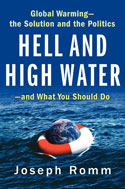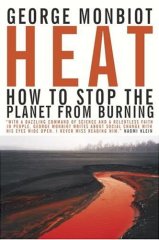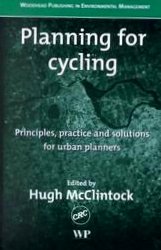 I’ve finally found the climate change book that I can recommend widely: Hell and High Water by Joseph Romm, 2006. I urge you to read it, as soon as you can.
I’ve finally found the climate change book that I can recommend widely: Hell and High Water by Joseph Romm, 2006. I urge you to read it, as soon as you can.
Why do I recommend this particular book?
- Clear and accessible. A wide audience can appreciate this book: the language is simple, the opening sections are organized into a story arc, and the numbers and scientific details are kept to a minimum.
- Smart science and smart politics. There are dozens of excellent books on the science alone, and a few good political ones, but very few that really understand both.
- Solutions, not just problems. If you’re going to paint a picture of a monumental challenge to humanity, have the grace to show how we might solve it.
- Alarming, but not alarmist. The problem is a daunting one, but Romm does not exaggerate it or lend any more terror to the issue than warranted by the science.
- Urgency. The problem is truly urgent, and demands immediate action within the next decade. The reasons for this are challenging to explain, but absolutely necessary.
- Achievable fixes, not impossible dreams and moral lessons. This isn’t an environmentalist’s rant about the evils of consumerism. Romm spares us the sermons and gives a clear illustration of the way forward, without requiring massive change from hundreds of millions of unwilling people.
- Good references. The book itself is not complete, but Romm’s blog answered many of my follow-on questions after I finished the book.
Joe Romm has a blog (ClimateProgress), but I really recommend reading his book first. The blog is more technical, but it’s also less suitable just because it’s a blog and not a book: less structured, more opinionated, and including news that is often depressing. That said, it’s a great place to continue learning about the subject after you finish the book. The package of policies he proposes in the book for 2010-2060 are part of path leading to 550ppm CO2, based on the 2006 consensus. Since then, a number of scientific findings have pushed Romm to prefer a 450ppm target, and he has put forward a series of posts on the subject; I’d suggest starting with the [Updated:] climate change impacts discussion, then the full solutions package [updated March 2009] and then reading the rest of the series. But really, get the book first.
If you’re a climate skeptic who is willing to be persuaded by good arguments, please give the book a try. You may need to suspend the disbelief for a while, and particularly forget some of the disinformation you’ve likely absorbed from the popular media. Keep the skepticism—it’s healthy!—hear the argument out, and then follow up with one of the dozens of books on the science itself, or one of the documentaries showing how the climate denial industry has waged a relentless P.R. campaign to prevent action on this issue. If you’re a science major or researcher, you can probably understand how the IPCC process works, and can dig deep into the IPCC reports themselves and inspect the arguments first-hand. If you’re not a science major, the whole process is much more opaque and the denial industry arguments can sound persuasive; I don’t have a good book to make the case to skeptical non-scientists yet.
Coming up soon: a review of the urgency, and a look at the transportation component of Romm’s plan.

